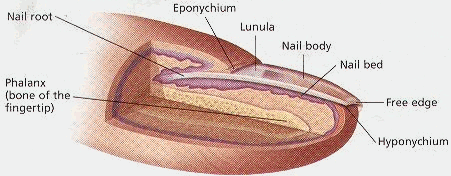Introduction to the Integumentary System
The skin, the biggest organ in your body and possibly one of the most essential systems. The integumentary protects the body, helps in homeostasis and provides our bodies with a sense of touch. Without the skin our bodies would fall apart, be extremely prone to diseases and would be susceptible to UV rays.
3 Layers of Skin:
-
Epidermis- The thin, outermost layer of skin consisting of epithelial cells. The epidermis is the layer which protects the body, is involved in absorbing nutrients, and helps in homeostasis. The epidermis has cells containing the protein keratin, which keeps the skin waterproof. Keratin is also the protein which gives fingernails their strong prtective quality. Millions of these dead skin cells are rubbed off each day. A pigment called melanin is also in the epidermis which protects the body from UV rays.
-
Dermis- The thick middle layer of skin that is composed of connective tissue. It is where nerves and blood vessels are. Most activity and homeostasis functions in the skin happen in the dermis. It holds glands which secrete oil and sweat involved in homeostasis. In the dermis hair is grown at the hair follicles. The erector pili are small muscles that are what causes your hair to stand up.
-
Subcutaneous Layer- The subcutaneous layer, also called the hypodermis, is the innermost layer of skin. It consists of cells that absorb fat.
Homeostasis
The inegumentary system has many functions that are involvein homeostasis. For example, sweat glands secrete sweat onto the epidermis which keeps the body from getting too hot. To keep the body warm your skin has small hairs all over to provide warmth like a blanket. Also the erector pili, which makes your hair stand up, helps you stay warm when its too cold outside. In order to keep the skin from drying out, oil glands secrete oil onto the epidermis.
Nails
Nails are grown from the thin area called the nail matrix at the base of the nail. Nails are mostly made of a hardened protein called keratin. Nails give us some protection, help support our fingertips, and increase the amount of sensation we feel from touch. Although their evolutionary purpose was as defense or to hunt and eat animals, some diseases or problems in the body can be detected by the state of a person's nails.
Integumentary System
Some Pictures of the Integumentary System.
Click to expand the images.
Disease
Skin cancer is a very common disease to occur in the integumentary system. This cancer destroys skin cells and bone cells in the long run. This may be caused by prolonged exposure to UV radiation. Another disease would be herpes. Herpes, which may be an STI causes sores on the skin.
 integumentary system diagram.jpg |
|---|
 Nail diagram.gif |
 Skin under microscope.jpg |
Crash Course Videos on the Integumentary System
By: Lorenzo Lizardi